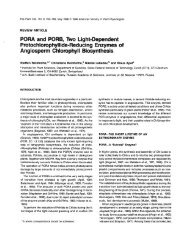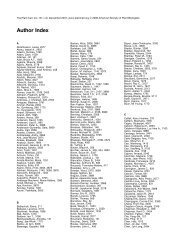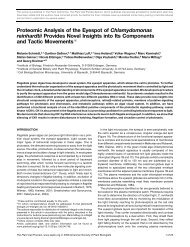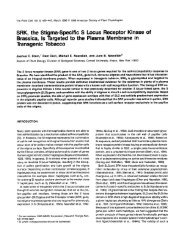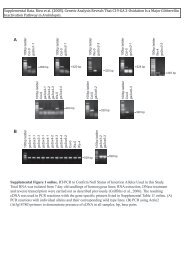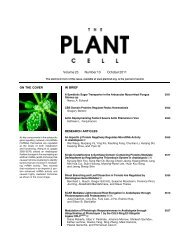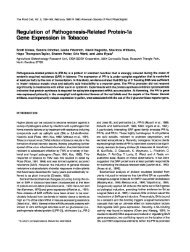The Shikimate Pathway: Early Steps in the ... - The Plant Cell
The Shikimate Pathway: Early Steps in the ... - The Plant Cell
The Shikimate Pathway: Early Steps in the ... - The Plant Cell
Create successful ePaper yourself
Turn your PDF publications into a flip-book with our unique Google optimized e-Paper software.
910 <strong>The</strong> <strong>Plant</strong> <strong>Cell</strong><br />
have speculated that <strong>the</strong> enzyme may merely catalyze <strong>the</strong> oxi-<br />
dation and <strong>the</strong> reduction, with <strong>the</strong> o<strong>the</strong>r identified steps <strong>in</strong> <strong>the</strong><br />
overall reaction mechanism proceed<strong>in</strong>g spontaneously. <strong>The</strong><br />
mung bean (Yamamoto, 1980) and pea(Pomplian0 et al., 1989)<br />
enzymes have been purified, but no cDNA encod<strong>in</strong>g this<br />
enzyme has yet been isolated from any higher plant. 3-Dehydro-<br />
qu<strong>in</strong>ate synthase is <strong>the</strong> only plant enzyme of <strong>the</strong> shikimate<br />
pathway for which no primary structural data are available.<br />
3-Dehydroqu<strong>in</strong>ate Dehydratase'<strong>Shikimate</strong><br />
De hyd rogenase<br />
In higher plants, <strong>the</strong> third and fourth steps of <strong>the</strong> shikimate<br />
pathway are catalyzed by a bifunctional enzyme (Koshiba, 1978;<br />
Polley, 1978). In mung bean, <strong>the</strong> moss Physcomitrella patens,<br />
sp<strong>in</strong>ach, pea, and tobacco, <strong>the</strong> 3-dehydroqu<strong>in</strong>ate dehydratase<br />
and shikimate dehydrogenase activities reside on a s<strong>in</strong>gle poly-<br />
peptide (Fiedler and Schultz, 1985; Mousedale et al., 1987).<br />
Such bi- or even multifunctional enzymes are found <strong>in</strong> severa1<br />
am<strong>in</strong>o acid biosyn<strong>the</strong>tic pathways, but homologous reactions<br />
are sometimes structurally organized <strong>in</strong> different ways <strong>in</strong> differ-<br />
ent organisms. For example, <strong>in</strong> Neurospora crassa (Case and<br />
Giles, 1968), Schizosaccharomyces pombe (Nakanishi and<br />
Yamamoto, 1984), Aspergillus nidulans (Charles et al., 1986),<br />
and Saccharomyces cerevisiae (Duncan et al., 1987), <strong>the</strong> sec-<br />
ond through sixth reactions of <strong>the</strong> shikimate pathway are<br />
catalyzed by a pentafunctional polypeptide encoded by <strong>the</strong><br />
arom gene. In contrast, <strong>in</strong> <strong>the</strong> bacteria E. coli and Salmonella<br />
typhimurium, <strong>the</strong> seven enzymes of <strong>the</strong> shikimate pathway are<br />
all <strong>in</strong>dividual polypeptides.<br />
Fungi have two 3-dehydroqu<strong>in</strong>ate dehydratases with little<br />
apparent sequence homology (Giles et al., 1985). <strong>The</strong> type I<br />
enzyme is heat labile, catalyzes a syn elim<strong>in</strong>ation (Hanson and<br />
Rose, 1963), and has K,,, values <strong>in</strong> <strong>the</strong> lower micromolar<br />
range. <strong>The</strong> type II enzyme is heat stable, catalyzes a tfans elimi-<br />
nation (Harris et al., 1993), and has K,,, values one to two<br />
orders of magnitude higher than those of <strong>the</strong> type I enzyme.<br />
In general, <strong>the</strong> type II enzyme participates <strong>in</strong> 3-dehydroqu<strong>in</strong>ate<br />
degradation (see later discussion).<br />
<strong>The</strong> 3-dehydroqu<strong>in</strong>ate dehydratases of most bacteria and<br />
higher plants are type I enzymes. In <strong>the</strong> E. coli3-dehydroqu<strong>in</strong>-<br />
ate dehydratase, a histid<strong>in</strong>e residue (Deka et al., 1992) and<br />
a lys<strong>in</strong>e residue (Chaudhuri et al., 1991) are <strong>in</strong> <strong>the</strong> active site<br />
of <strong>the</strong> enzyme. A type I enzyme has beea crystallized from<br />
S. typhimurium; <strong>the</strong> crystals refract to 2.3-A resolution (Boys<br />
et al., 1992). A type II 3-dehydroqu<strong>in</strong>ate dehydratase (Garbe<br />
et al., 1991) from Mycobacterium tyberculosis has been crys-<br />
tallized; <strong>the</strong> crystals refract to 2.2-A resolution (Gourley et al.,<br />
1994). <strong>The</strong> analysis of <strong>the</strong>se crystals will yield structures that<br />
may reveal some fundamental differences <strong>in</strong> <strong>the</strong> reaction mech-<br />
anisms of enzyme-catalyzed syn and anti water elim<strong>in</strong>ation.<br />
Severa1 forms of <strong>the</strong> bifunctional 3-dehydroqu<strong>in</strong>ate de-<br />
hydratase'shikimate dehydrogenase have been purified to<br />
electrophoretic homogeneity from <strong>the</strong> stroma of sp<strong>in</strong>ach chlo-<br />
roplasts (Fiedler and Schultz, 1985). <strong>The</strong> turnover number of<br />
3-dehydroqu<strong>in</strong>ate dehydratase is approximately one-n<strong>in</strong>th that<br />
of shikimate dehydrogenase, so dehydroqu<strong>in</strong>ate is readily con-<br />
verted to shikimate without accumulation of dehydroshikimate.<br />
<strong>The</strong> leve1 of dehydroshikimate is apparently kept low to pre-<br />
vent <strong>in</strong>duction of <strong>the</strong> catabolic pathway to protocatechuate (see<br />
later discussion).<br />
Partia1 cDNAs encod<strong>in</strong>g <strong>the</strong> 3-dehydroqu<strong>in</strong>ate dehydra-<br />
tase'shikimate dehydrogenase of pea (Deka et al., 1994) and<br />
tobacco (Bonner and Jensen, 1994) have recently been cloned<br />
us<strong>in</strong>g antibodies aga<strong>in</strong>st <strong>the</strong> pure bifunctional pea and tobacco<br />
enzymes. Although nei<strong>the</strong>r cDNA is full length, <strong>the</strong> more ex-<br />
tensive tobacco sequence <strong>in</strong>cludes <strong>the</strong> entire cod<strong>in</strong>g region<br />
for <strong>the</strong> mature bifunctional enzyme plus 69 nucleotides up-<br />
stream of this region. <strong>The</strong> latter were speculated to encode<br />
part of a transit peptide for plastid import. This putative transit<br />
peptide is rich <strong>in</strong> hydroxylated am<strong>in</strong>o acid residues but has<br />
a net negative charge, a feature not yet seen for any o<strong>the</strong>r chlo-<br />
roplast transit peptide (Archer and Keegstra, 1990; Gavel and<br />
von Heijne, 1990). Pairwise sequence alignments of <strong>the</strong> two<br />
doma<strong>in</strong>s of <strong>the</strong> bifunctional tobacco dehydratase-dehydro-<br />
genase with <strong>the</strong> monofunctional homologs from o<strong>the</strong>r organisms<br />
show that <strong>the</strong> plant enzymes are evolutionarily closer to <strong>the</strong>ir<br />
prokaryotic than to <strong>the</strong>ir lower eukaryotic homologs. Am<strong>in</strong>o<br />
acid sequence identities vary from 24 to 36%.<br />
<strong>Shikimate</strong> K<strong>in</strong>ase<br />
In <strong>the</strong> fifth step of <strong>the</strong> pathway, a k<strong>in</strong>ase phosphorylates shiki-<br />
mate to yield shikimate 3-phosphate. Elim<strong>in</strong>ation of this<br />
phosphate two steps later leads to <strong>the</strong> second double bond<br />
of <strong>the</strong> benzene r<strong>in</strong>g. E. coli has two shikimate k<strong>in</strong>ases of simi-<br />
lar size but with different K,,, values for shikimate: m5 mM for<br />
enzyme I, and 200 pM for enzyme II (Whipp and Pittard, 1995).<br />
Enzyme II may be <strong>the</strong> major activity for chorismate biosyn<strong>the</strong>-<br />
sis. <strong>The</strong> three-dimensional structure of shikimate k<strong>in</strong>ase II was<br />
predicted by computer model<strong>in</strong>g based on adenylate k<strong>in</strong>ase<br />
coord<strong>in</strong>ates (Matsuo and Nishikawa, 1994). <strong>The</strong> syn<strong>the</strong>sis of<br />
enzyme II is subject to regulation by <strong>the</strong> tyr and trp repres-<br />
sors; enzyme I is syn<strong>the</strong>sized constitutively (Heatwole and<br />
Somerville, 1992).<br />
<strong>Plant</strong> shikimate k<strong>in</strong>ases have been described from pea<br />
(Mousedale and Cogg<strong>in</strong>s, 1985) and rice (Kavi Kishor, 1989),<br />
and <strong>the</strong> activity has been purified to near homogeneity from<br />
sp<strong>in</strong>ach chloroplasts (Schmidt et al., 1990). <strong>The</strong> first plant cDNA<br />
encod<strong>in</strong>g shikimate k<strong>in</strong>ase was isolated from tomato (Schmid<br />
et al., 1992) by perform<strong>in</strong>g <strong>the</strong> polymerase cha<strong>in</strong> reaction us<strong>in</strong>g<br />
as primers two oligonucleotides whose sequences are con-<br />
served between genes for <strong>the</strong> E. coli (DeFeyter et al., 1986;<br />
Millar et al., 1986), Erw<strong>in</strong>ia chrysan<strong>the</strong>mi(M<strong>in</strong>ton et al., 1989),<br />
and S. cerevisiae (Duncan et al., 1987) enzymes. <strong>The</strong> deduced<br />
am<strong>in</strong>o acid sequence of <strong>the</strong> tomato enzyme conta<strong>in</strong>s an N-termi-<br />
na1 extension that resembles a transit sequence for chloroplast<br />
import. Indeed, <strong>in</strong> vitro-syn<strong>the</strong>sized tomato shikimate k<strong>in</strong>ase<br />
precursor is processed and taken up by isolated sp<strong>in</strong>ach chloro-<br />
plasts (Schmid et al., 1992). DNA gel blots of tomato genomic




